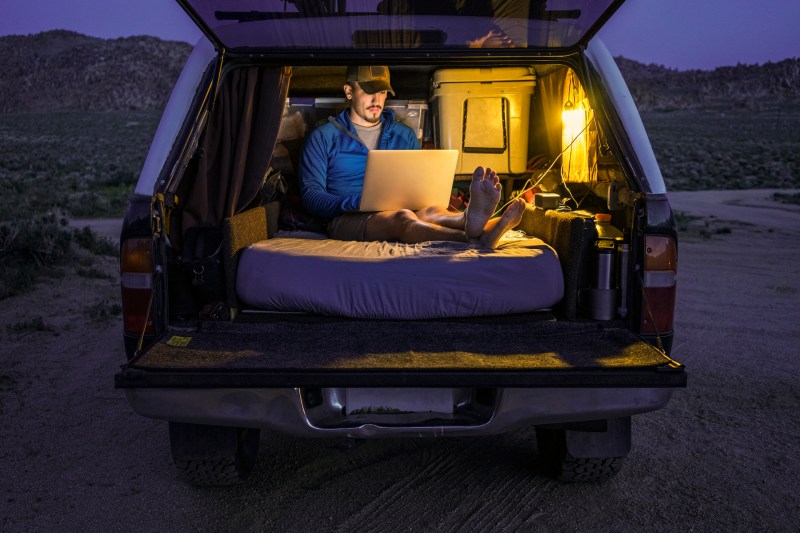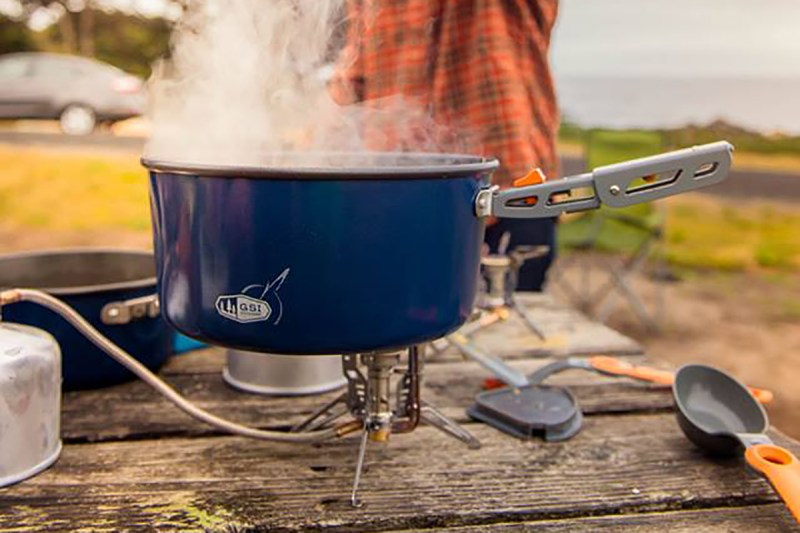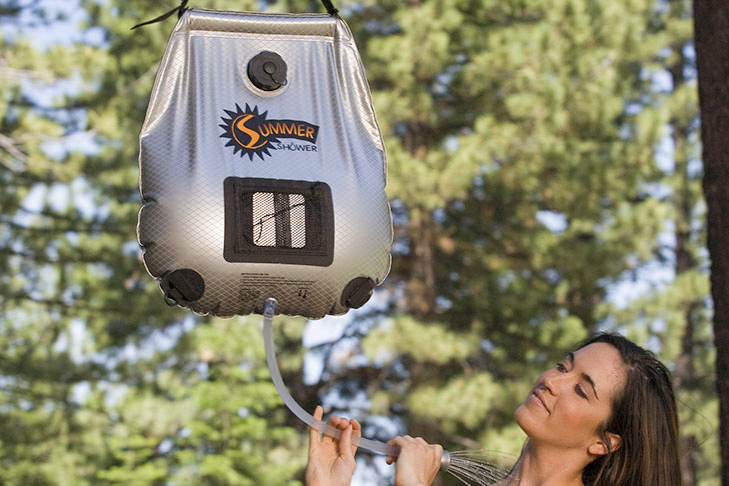
The van-life movement has evolved beyond short-term escape into a way of life in the most minimal and sustainable sense. Should you decide to spend days or weeks traversing the country on four wheels sounds appealing, then this one is for you. We’ve put together a starter kit of essential tips and gear — most of which is similar to any extended car camping trip.
Here’s everything you’ll need to stay safe, sane, and happy when living in your car (or truck or van) for a few weeks or even longer. Whether you’re trying to fully embrace van life or just planning an extended road trip to get out of your house, here’s the low-down on how to live in your car.
Learn how to get a good night’s rest

We’ll assume that sleeping outside of your car isn’t an option (if it is, then we suggest buying the best camping tent you can afford). Maybe it is because you don’t have the available space, or you can’t afford nightly campground fees, or you just really hate bugs. Unfortunately, the backseat of most stock vehicles isn’t designed to sleep comfortably, warmly, or quietly. They’re bumpy, lumpy, and the seatbelts are bound to dig into places seatbelts weren’t meant to go.
Your best bet is to invest in a decent camping mattress. There are two main options: A good camping air mattress or a camp-friendly sleeping pad. The former is best for saving space as you can deflate it and stow it out of the way during the day. The downside is that you’ll need to reinflate it every night, and some people (this humble author included) find it’s about as comfortable as sleeping on a pool float. A foam mattress, on the other hand, is often softer and more comfortable. However, they tend to sleep “hot” (which is even more of a problem should you need to sleep with the windows up) and also take up a lot of space even when not in use.
No matter the time of year, don’t forget a four-season blanket. is a duck-down-filled champ that’s just as comfortable in the heat of summer as the dead of winter. If cold weather will be an issue, consider a well-made sleeping bag or an alternative like . Sure, they look ridiculous, but I can personally vouch that they work as advertised.
Spend any considerable time living out of your car, and you’ll discover night-time ventilation is as critical to a good night’s sleep as your mattress choice. are vehicle window screens that attach magnetically to the car’s door frame and allow you to keep the windows down overnight. Just keep in mind that they only protect against insects, not rain, theft, or legit bear attacks.
Lastly, sleeping in your car can be surprisingly noisy, especially if you’re not set up in a campground with quiet hours and the like. Unless you’re a heavy sleeper, we recommend investing in good earplugs. Mack’s Ultra Soft Foam Earplugs are a perennial favorite — they’re inexpensive, comfortable, and reduce ambient noise by up to 32 decibels when worn properly. Of, if you’re an especially light sleeper, splurge on a pair of noise-canceling sleep-centric earbuds like the .
Knowing how to cook on the road is essential

Packing your mobile camp kitchen is one area that can quickly get out of control if you let it. It’s tempting to pack every conceivable pan, dish, utensil, opener, tool, and small appliance that you might need. But it’s best to keep it simple, and leave out anything that feels like a “just in case” item. Take only one of everything, focusing on items that can pull double- or triple-duty. A decent oversized mug, for example, works for soup, cereal, coffee, pasta, and more without the need to pack a separate vessel for each. Sporks are versatile and can replace a handful of utensils and other plasticware. Gerber’s latest Compleat Multi-Fork is lightweight, indestructible, and non-corrosive.
For the right camping cookware, we recommend two all-in-one sets. GSI Outdoors’ entire line of camp gear is ultra-portable and well-made. The Gourmet Kitchen Set 11 includes all the cookware — spoon, spatula, cutting board, scraper, whisk, and condiment containers — you need to cook almost any basic meal. The two-person Pinnacle Backpacker Cookset upgrade includes just about everything else. The compact nesting set features a two-liter pot, a Teflon-coated frypan, a strainer lid, insulated mugs with sip-through lids, bowls, and a folding pot handle.
Clean water is a must-have too. Invest in a solid water jug that’s both easy to clean and guaranteed not to leak. Dometic GO Hydration Water Jug 11L. It’s rugged, reasonably compact, lightweight (when empty), and holds just under three gallons of water. Add on the company’s companion for access to “running water” virtually anywhere.
Access to cold or frozen food is one thing that really separates merely surviving in your car and living in your car. It’s tempting to go the inexpensive route and bring a cooler. It’s not a bad idea, although we’d strongly recommend investing in the best Yeti-like cooler you can afford — one that keeps your beer and fine cheese selection chilled for days. (available in 32-quart and 52-quart wheeled varieties) are perfect for living in your car. But if you have the extra cash, splurging on a portable fridge is the way to go. It might seem like a luxury. But trust us, if there are two things worth spending a little more on, it’s a good mattress and a portable fridge. Here, we again recommend Dometic, especially the company’s .
Of course, even more important than clean clothes and hot meals is access to a cup (or a pot) of morning coffee. We’ve covered a ton of portable coffee-making options. For pure convenience, we like Starbucks VIA Instant Coffee or . The single-serve packets require only hot water and a vessel to serve it in. Stir and enjoy. For a proper cup of espresso on the go, is the closest thing you’ll find to homebrew. It does require a bit more work and maintenance, but the payoff is a surprisingly good cup of espresso anywhere, anytime. So, there’s that.
Cleanliness really is next to Godliness on the road

Showering is even more important when you’re living out of your car. Not only is it key to, ya know, staying clean, but it’s a simple way to refresh and feel human again. is our hands-down pick for the best portable shower. It’s a powder-coated aluminum tube that mounts to almost any automotive roof rack. The clever design relies on solar power to heat the water, while the attached hose delivers a pressurized stream wherever you need it. It’s ideal for showering, washing dishes, keeping your pets clean, and more. The downside? It’s pricey.
For a cheaper option, invest in a simple solar shower. The Advanced Elements Solar Summer Shower holds five gallons of water and hangs anywhere that’s reasonably sturdy, like off your vehicle’s roof rack or an open hatchback. The gravity-fed hose doesn’t deliver the same ultra-refreshing blast of water as the RoadShower. But, at less than $35, it’s a solid, affordable alternative.
Clean socks and underwear make all the difference, too

Doing laundry while camping at a full-service campground can prove challenging, let alone keeping your drawers clean while living out of your car. The best solution we’ve found is Scrubba. It’s a purpose-built dry bag with a built-in washboard designed to give your laundry an almost-machine-quality wash in less than ten minutes.
As you might expect, it takes a little elbow grease (think Little House on the Prairie), but it’s a small price to pay for not smelling like an old-timey railway hobo. For go-anywhere, biodegradable laundry detergent, check out Campsuds (Bonus: the concentrated solution is safe on dishes and skin as well).
Organize your car camping essentials

Even a full-sized Lincoln Navigator will start to feel cramped when you’re living in it. Storage becomes difficult, but keeping everything organized is the only way to ensure you don’t spend hours every day trying to find your snacks or socks.
The MaxWorks Collapsible Storage Organizer from MaxxHaul is a simple solution to keep all your essentials right where you left them. Each soft-sided section allows you to sort, for example, clothing, kitchen, automotive supplies, and toiletries/first-aid gear into their own space. The cheapest alternative — and one we’ve found surprisingly effective — is to use a few milk crates. They’re sturdy, ubiquitous, and stack neatly. Plus, they’re virtually free if you know where to look.
Your other alternative is to invest in a few compact, packable duffel bags. We like . It packs down insanely small (about the size of a softball), but unfurls to a capacious 30 liters of space. Get one for your perishable food, one for your clothes and toiletries, and one for your bedding to keep everything wrangled in the back of your car.
Remember to get some (or a lot of) fresh air while living in your car

If you have the outside space, setting up a makeshift “living room” makes all the difference in your car-living experience. We love the . It collapses down into a tight roll that attaches to almost any vehicle roof or roof rack. Once unfurled, the 9-foot-by-7-foot cover provides ample room for a couple to relax in a campground, at the beach, or even a parking lot. The lightweight nylon canopy is also sturdy and waterproof, so it’s just as useful in light rain.
The Neso 1 from Neso Tents is another great alternative. While they’re primarily billed as beach tents, the lightweight sunshades set up easily just about anywhere. Plus, they stow inside a compact, 19.5-inch carry bag and cost less than half as much as a MoonShade.
Stay connected and powered up from anywhere

It’s one thing to vow to disconnect (or digitally detox) when you’re planning a weekend camping trip. But if you are living in your car for weeks or longer, you’re going to need a way to stay connected and keep your electronics charged. At the very least, you’ll want a reliable source of power for a smartphone and a laptop.
Portable power banks (sometimes called “solar generators”) are the way to go. They come in all shapes, sizes, and capacities, but for most “average” car campers looking for basic on-the-go backup power, we love Goal Zero’s Yeti 200X. It’s compact, relatively lightweight, and easy to use. Plus, the 187Wh capacity is plenty for anyone but the most gadget-obsessed packers.
If you’re planning to travel gear-heavy (laptop, cell phone, digital camera, drone, and more), consider going with a heavy-duty option like Ugreen’s all-new . With a beefy, 1024Wh LiFePO4 battery, it offers more than enough juice to keep you powered up for days or, with a few solar panels, weeks on the road in your car.
Lastly, a reliable cellular connection is essential, both for safety and for anyone planning to WFH while living in their car. is excellent for keeping connected for daily Zoom calls, social media check-ins, or remote WFH sessions. The device mounts out of sight in your car and boosts even the weakest cellular signals, making them stronger, more useful, and more reliable. It’s compact, easy to install, and relatively affordable, especially if you absolutely can’t live without internet connectivity on the road.
Learn how to live in your car in ‘stealth mode’

It’s one thing if you’re planning to stay mostly in campgrounds or disperse camp on public land. But, if you’ll be spending time in parking lots or anywhere more exposed to the public while living in your car, it pays to be able to do so stealthily. There’s nothing worse than getting a 3 a.m. “wake-up call” from the police or an angry shop owner with a stern warning to vacate the property ASAP or else.
The best way to avoid this is to make your car look as stealthy and ordinary as any other car on the road.
- A roof rack packed to the gills with totes and gear in a Walmart parking lot at midnight is a dead giveaway that someone might be living inside the vehicle.
- After dark, avoid using bright lights or headlamps inside, as these can easily be seen by passers-by.
- Consider tinting your vehicle’s windows (at least the rear half) to increase privacy and shield your mobile living space from prying eyes.
Once you’ve settled in to sleep or just relax for the night, keep your trips in and out of the car to a minimum. Repeatedly climbing in and out of the back hatch of an SUV is another sign that you might be planning to sleep inside. Also, be sure to crack a window or sunroof. This not only provides better ventilation, but it can keep your windows from fogging up from the condensation of your breath during the night (another dead giveaway to outsiders that someone may be sleeping inside).
Remember: Paper maps never need a signal

One of the advantages of living in your car on an extended road trip is that you can go just about anywhere. Sure, most of us rely on our cell phones to get us where we’re going, but the problem with that method is phones need a signal to work, and if you go off the beaten path, that signal could be lost. That’s where an old-school solution comes in: the good old-fashioned paper map. They never run out of battery power and you can use them anywhere.
One of the most handy atlases out there is the National Geographic Road Atlas, which has colorful, easy-to-read maps, and it comes in a spiral-bound cover that allows it to stay open, making it easy to use. You can also get local maps from any tourist center, and most of the time, those are free. So grab a good map and get out there.


